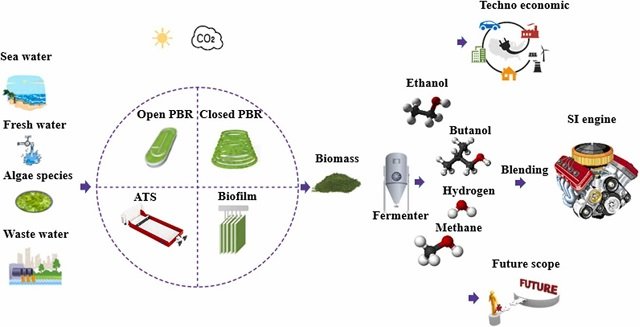
Imagine harnessing the power of sunlight to create medicines, clean fuels, and essential chemicals! This is the promise of ‘green biotechnology,’ and cyanobacteria are the tiny champions at the forefront. These photosynthetic bacteria act as natural ‘bioreactors,’ powered by the sun and adept at converting CO2 into valuable products.
But there’s a problem: the current production levels of cyanobacteria lag behind other organisms. Researchers at Vanderbilt University have now discovered a new strategy to unlock the full potential of cyanobacteria: manipulating their internal clock. This ‘circadian clock’ regulates gene expression throughout the day, affecting the efficiency with which cyanobacteria produce the desired molecules.
The research team, led by Carl H. Johnson, Cornelius Vanderbilt Professor of Biological Sciences, has managed to adjust the daily biological clock of cyanobacteria, making these blue-green algae a more prolific producer of renewable fuels, chemicals, and pharmaceuticals like insulin.
Why cyanobacteria?
These unicellular wonders boast several advantages:
- Solar-powered: They harness sunlight for energy, making them a sustainable and eco-friendly option.
- CO2 fixers: They efficiently capture carbon dioxide, a greenhouse gas, and convert it into useful compounds.
- Simple needs: They thrive in minimal environments and require few resources.
Breaking the bottleneck: Reprogramming the internal clock
For years, scientists have been working to make cyanobacteria a more fruitful and versatile microbial cell factory. However, research has not advanced as quickly as it has with other microbes like E. coli and yeast.
Despite their potential, traditional methods to boost bioproduction in cyanobacteria, such as using strong promoters, have not yielded optimal results. This new study reveals a fundamental oversight: these approaches ignored the stringent control exerted by the circadian clock.
The circadian clock is an internal mechanism that regulates gene expression throughout the day-night cycle. This clock, even under constant light conditions, can repress gene expression during its simulated ‘night’ phase. This significantly limits the potential for continuous bioproduction.
By genetically modifying cyanobacteria to bypass the internal clock repressors and even disabling the central clock mechanism, scientists have achieved a dramatic increase in bioproduct expression. Essentially, this ‘reprograms’ the bacteria to focus on producing the desired molecules at much higher levels.
Stay Always Informed
Join our communities to instantly receive the most important news, reports, and analysis from the aquaculture industry.
Hacking the clock to enhance production
The researchers have devised a novel strategy: reprogramming gene expression by manipulating the circadian machinery. They employed:
- Disabling repression: The scientists identified a protein called LabA that acts as a repressor, dampening the activity of RpaA, a key player in gene expression. By genetically modifying cyanobacteria to avoid LabA repression, they can keep RpaA ‘on’ more consistently.
- Clock inactivation: The study also involved manipulating the core clock components (KaiA, KaiB, and KaiC) by overexpressing KaiA. This essentially ‘overwhelms’ the clock, preventing it from entering its repressive phase.
By targeting the repressive elements and the central clock mechanism, they have successfully ‘unlocked’ the production of valuable molecules:
- Biomedically relevant enzymes: These molecules can be used in various applications, from drug development to bioremediation.
- Bioactive polypeptides: These chains of amino acids have immense potential in the medical field.
‘Instead of simply focusing on traditional ways to drive stronger gene expression of the desired product, we reasoned that the biological clock modulating gene expression could be manipulated to produce more things around the clock,’ Johnson said. ‘By inactivating the internal biological clock of cyanobacteria and its repression of gene expression, we could now achieve a significant upregulation of green bioproducts, including medicinal insulin.’
The future of green biofabrication
This work focused on cyanobacteria is especially important because they are easy and cost-effective to cultivate, using sunlight as an energy source and thriving in nutrient-poor environments. The findings could enable green biotechnology to advance at an accelerated pace.
The goal of green biotechnology is to develop genetically altered photosynthetic organisms to serve as ‘bioreactors’ that produce renewable fuels, pharmaceuticals, and chemical precursors with minimal environmental impact.
By harnessing the power of sunlight and the natural capabilities of cyanobacteria, scientists are taking a significant step towards more sustainable and efficient production of valuable products.
The study was supported by grants from the National Institute of General Medicine Sciences, the Department of Energy, and the National Institutes of Health.
Contact
Carl Hirschie Johnson
Department of Biological Sciences, Vanderbilt University
Nashville, TN 37235
Email: carl.h.johnson@vanderbilt.edu
Reference (open access)
Yao Xu, Maria Luísa Jabbur, Tetsuya Mori, and Carl Hirschie Johnson. 2024. Clocking out and letting go to unleash green biotech applications in a photosynthetic host. PNAS, 121 (21) e2318690121 https://doi.org/10.1073/pnas.231869012
Editor at the digital magazine AquaHoy. He holds a degree in Aquaculture Biology from the National University of Santa (UNS) and a Master’s degree in Science and Innovation Management from the Polytechnic University of Valencia, with postgraduate diplomas in Business Innovation and Innovation Management. He possesses extensive experience in the aquaculture and fisheries sector, having led the Fisheries Innovation Unit of the National Program for Innovation in Fisheries and Aquaculture (PNIPA). He has served as a senior consultant in technology watch, an innovation project formulator and advisor, and a lecturer at UNS. He is a member of the Peruvian College of Biologists and was recognized by the World Aquaculture Society (WAS) in 2016 for his contribution to aquaculture.




